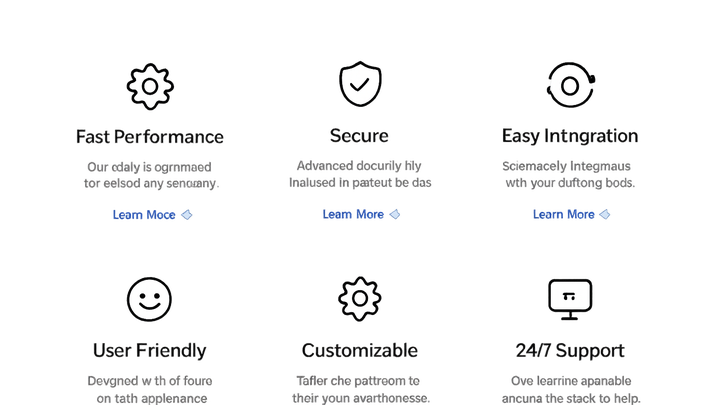Published on 2025-06-29T21:07:26Z
What is a Homepage Feature Grid? Examples & Best Practices
Homepage Feature Grid is a structured layout on a website’s homepage that showcases core features, benefits, or services in a clean, grid-based format. This pattern arranges feature blocks—each typically containing an icon or image, a headline, and a brief description—in rows and columns to facilitate quick scanning and comprehension. From a CRO perspective, well-designed grids guide users’ attention, reduce decision fatigue, and strengthen calls-to-action, boosting conversion rates. On the UX side, feature grids leverage visual hierarchy, consistent design elements, and responsive behavior to ensure clarity across devices. SEO also benefits when these blocks include semantic HTML, descriptive headings, and optimized alt text for images, signaling relevance to search crawlers.
Common use cases include highlighting product capabilities, service offerings, or key value propositions immediately above the fold. Tools like Prevue.me can generate actionable critiques on grid clarity, CTAs, and SEO best practices to maximize lead generation.
Homepage feature grid
A homepage grid showcasing key features with icons, headlines, and CTAs to enhance user engagement, conversions, and SEO.
Why a Homepage Feature Grid Matters
Feature grids are foundational to guiding visitors through your value propositions. They support rapid scanning, reduce cognitive load, and help emphasize top benefits effectively. In the context of CRO, UX, and SEO, grids ensure that key messages are front-and-center, accessible, and measurable.
-
Clarity & quick scanning
Users often scan pages in F-patterns; a grid lays out features for immediate legibility and context.
-
Enhanced conversion paths
By pairing each grid item with a link or CTA button, you create clear micro-conversion opportunities.
-
Seo & semantic structure
Structuring feature blocks with proper heading tags and alt text boosts accessibility and search relevance.
Best Practices for Designing Your Feature Grid
Designing an effective feature grid involves balancing aesthetics, usability, and performance. Follow these guidelines to ensure your grid drives results across CRO, UX, and SEO metrics.
-
Consistent visual language
Use a unified icon set, typography, and color scheme to maintain brand cohesion and avoid confusion.
-
Responsive & mobile-friendly layout
Ensure your grid collapses gracefully on smaller screens, maintaining readability and button touch targets.
-
Accessibility considerations
Implement semantic HTML (e.g., <section>, <h3>), ARIA roles, sufficient color contrast, and descriptive alt attributes.
-
Clear call-to-actions
Each feature block should include a distinct CTA or link, guiding users toward the next step in their journey.
Examples of Effective Homepage Feature Grids
Real-world examples illustrate how different SaaS platforms implement feature grids to communicate value and drive engagement.
-
Prevue.me
prevue.me employs a clean 3x2 grid with custom icons, concise headlines, and a primary CTA “Get Feedback” beneath each block, optimized through actionable UX and SEO critiques.
-
Slack
Slack uses an alternating text-image grid, pairing feature descriptions with screenshots to create dynamic visual interest and highlight collaboration tools.
-
Trello
Trello’s homepage showcases color-coded cards in a responsive grid, each linking to dedicated feature pages that dive deeper into collaboration and workflow options.
Testing and Optimization Strategies
Continuous testing and refinement ensure your feature grid remains effective and aligned with audience needs.
-
A/b testing with optimizely
Experiment with grid layouts, imagery, and CTAs to identify the highest-converting variant.
-
Heatmap analysis via hotjar
Analyze click and scroll heatmaps to understand which grid items grab attention and adjust accordingly.
-
User surveys and feedback
Collect qualitative insights on feature comprehension and perceived value directly from users.
-
Performance & seo monitoring
Use Google Analytics and Search Console to track engagement metrics, dwell time, and organic traffic changes post-implementation.
